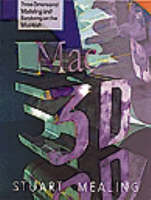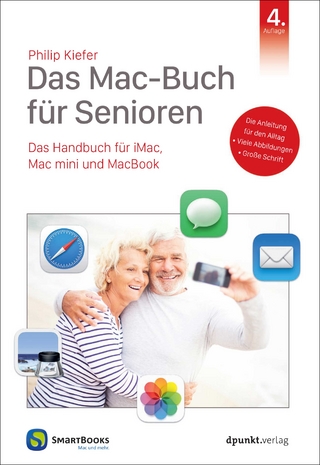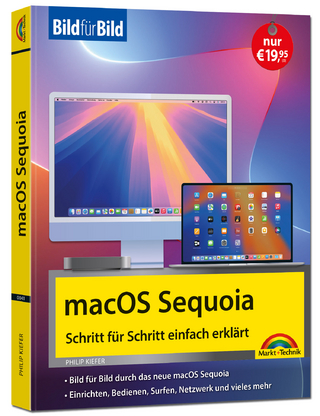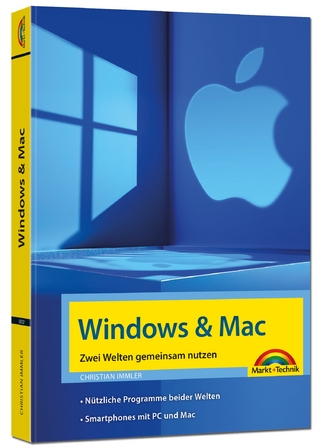
Mac 3D
Intellect Books (Verlag)
978-1-871516-46-3 (ISBN)
- Titel z.Zt. nicht lieferbar
- Versandkostenfrei innerhalb Deutschlands
- Auch auf Rechnung
- Verfügbarkeit in der Filiale vor Ort prüfen
- Artikel merken
This text looks at the uses of 3D computer modelling in product design, visualization and architecture, and introduces the basic theory and practice of the medium. Subjects range from co-ordinates to radiosity, from bump mapping to splines and from data compression to teleology. The work covers the underlying principles of different model-building methods, surface treatments and lighting methods, as well as material specific to the Macintosh: relevant hardware, file types, data compression, networking and expense. A large section considers in detail the software available, assessing the strengths, weaknesses and applications. Case studies test out different products on real projects and further chapters cover design methodology, principles and the future of modelling.
1 INTRODUCTION 1
2 MODELLING & RENDERING 5
2.1 What is modelling? 5
2.2 Navigating a 3-D Computer world 6 2.3 What is rendering? 8
2.4 The role of the designer 9
3 APPLICATIONS 11 3.1 Architecture 11 3.2 3-D design 13 3.3 Engineering 14 3.4 Simulation 15 3.5 Medical 17 3.6 TV graphics 18 3.7 Special effects 19 3.8 Art 20 3.9 Animation 21 3.10 Virtual reality 22
4 FUNDAMENTALS 25
4.1 Display 26
4.2 Coordinates 27
4.2.1 Relative and absolute 28
4.2.2 Cartesian coordinates 29
4.2.3 Polar and spherical coordinates 29
4.2.4 Homogeneous coordinates 30
4.3 Raster 30
4.4 Vector 31
4.5 Spllnes 31
4.6 Modelling 33
4.6.1 Methods 33
4.6.1.1 B-Rep 33
4.6.1.2 Primitives 34
4.6.1.3 Swept forms 34
4.6.1.3.1 Spun 35
4.6.1.3.2 Extruded 36
4.6.1.3.3 Freeform 37
4.6.1.4 Lofted 37
4.6.1.5 Skinned 38
4.6.1.6 CSG 38
4.6.1.7 Voxels 40
4.6.1.8 Fractals 41
4.6.1.9 Particles 41
4.6.1.10 Grammar-based 42
4.6.2 Joints 43
4.6.3 Flexibility 43
4.6.4 Deformation 44
4.6.5 Editing forms 44
4.7 Viewing models 45
4.7.1 Legibility 45
4.7.2 Wireframe 46
4.7.3 Hidden line 46
4.7.4 Depth cueing 48
4.7.5 Solid 48
4.7.5.1 Coded and lighted 49
4.7.6 Perspective 49
4.8 Rendering 51
4.8.1 Light Sources 51
4.8.2 Lighting models 52
4.8.2.1 Lambert 52
4.8.2.2 Gouraud 53
4.8.2.3 Phong 53
4.8.2.4 Blinn 54
4.8.2.5 Ray tracing 54
4.8.2.6 Radiosity
4.8.2.7 Photo-realistic 55
4.8.2.8 Specialised 55
4.8.3 Shadows
4.8.4 Surface characteristics 57
4.8.4.1 Procedural and non-procedural 57
4.8.4.2 Texture mapping 57
4.8.4.2.1 Dirt 58
4.8.4.3 Solid texture 58
4.8.4.4 Bump mapping 58
4.8.4.5 Image mapping 60
4.8.4.6 Reflection mapping 60
4.9 Current research 60
4.10 Artefacts 61
4.11 Animation 62
4.11.1 Key frame 63
4.11.2 Timeline 64
4.11.3 Scripted 64
4.11.4 Kinematic 65
4.11.5 Dynamic 65
4.11.6 Metamorphosis 66
5 THE MAC FOR MODELLING & RENDERING 67
5.1 The operating system 67
5.2 Mac hardware 68
5.2.1 CPU 68
5.2.2 Memory 70
5,2.3 Storage 72
5.2.4 I/O 74
5.2.5 Networking 75
5.3 Expansion 76
5.3.1 Accelerators 76
5.3.2 Emulators 77
5.4 Control hardware 78
5.5 Files 78
5.6 Compression 80
5.6.1 JPEG 82
5.6.2 MPEG 82
5.6.3 H.261 83
5.6.4 IFS 83
5.7 Customisation 83
5.8 Expense 85
5.8.1 Time 86
5.8.2 Money 86
5.9 Ergonomics 88
6 COMMUNICATING WITH THE MAC
6.1 Input devices 91
6.1.1 Keyboard 91
6.1.2 Mouse(+ variations) 92
6.1.3 2-D graphic tablet 93
6.1.4 3-D digitiser 94
6.1.5 Touch screen 95
6.1.6 Scanner 95
6.1.7 New input devices 96
6.1.8 Video 97
6.1.8.1 Still camera 97
6.1.8.2 Live camera 98
6.1.8.3 VTR 98
6.2 Output devices 99
6.2.1 VDU 99
6.2.2 Printer 99
6.2.3 Plotter 102
6.2.4 VTR 104
6.2.5 Still camera 104
6.2.6 Film camera 105
6.3 The screen interface 106
7 DESIGN METHODOLOGY
7.1 Planning 109
7.1.1 'World'map 109
7.2 Matching method to tools 110
7.3 The naming of parts 111
7.4 Salvation 112
7.5 Lateral thinking 113
7.6 Cheating 114
8 MACTYPICAL
8.1 MacTypical interface 117
8.2 MacTypical object creaction 118
8.3 MacTypical navigation 120
8.4 MacTypical rendering 123
8.5 MacTypical surface efects 125
8.6 MacTypical lighting 126
8.7 MacTypical extras 127
8.3 MacTypical animation 127
8.4 MacTypical file support 128
9 CASE STUDIES
9.1 Front cover-MAC 3D 131
9.2 Back cover-sunglasses 131
9.3 Back cover-building 135
9.4 Back cover-chain 138
10 THE FUTURE OF MODELLING
10.1 Virtual Reality 145
10.2 Dynamics 146
10.3 Intelligent models 148
10.4 Digital dough 150
10.5 Catalogues 151
10.6 And finally 153
Appendix 1: MODELLING & RELATED SOFTWARE
Summer of applications described 155
Infini-D 157
StrataVision 3D 162
Ray Dream Designer 167
Swivel 3D Professional 172
MacroModel 177
Alis Sketch! 181
Form Z 190
ModelShop II 194
MiniCad + 199
AutoCAD 203
Virtus Walkthrough 208
addDepth 210
Adobe Dimensions 214
MacroMindThree-D 217
MacRenderMan 220
LifeForms 224
Touch-3D 226
deBabelizer 228
Other relevant software 229
Appensiz 2: GLOSSARY OF TERMS 233
BIBLIOGRAPHY 244
INDEX 245
| Erscheint lt. Verlag | 1.5.1994 |
|---|---|
| Sprache | englisch |
| Themenwelt | Informatik ► Betriebssysteme / Server ► Macintosh / Mac OS X |
| Informatik ► Grafik / Design ► Digitale Bildverarbeitung | |
| ISBN-10 | 1-871516-46-3 / 1871516463 |
| ISBN-13 | 978-1-871516-46-3 / 9781871516463 |
| Zustand | Neuware |
| Informationen gemäß Produktsicherheitsverordnung (GPSR) | |
| Haben Sie eine Frage zum Produkt? |
aus dem Bereich


